
Click the name of a planet to learn more about its visibility in March 2021: Jupiter, Saturn, Mars, Venus, Mercury
Try Stellarium for a precise view of the planets from your location.
Want precise planet rise and set times? Click here for recommended almanacs
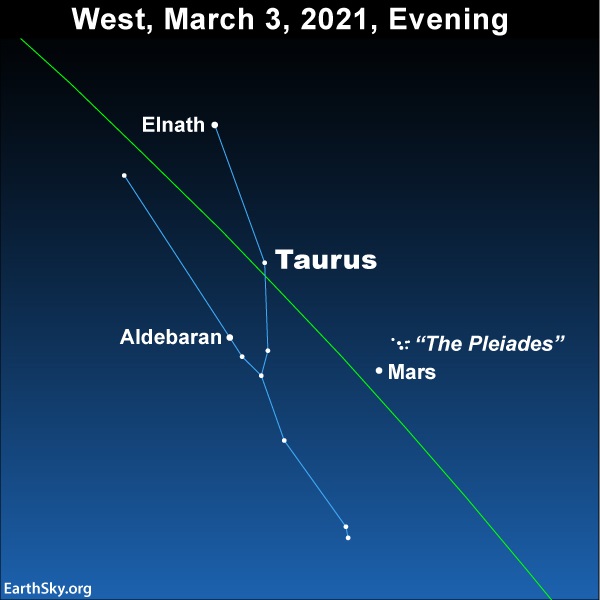
The red planet Mars has a conjunction with the Pleiades star cluster every other year. But the Mars-Pleiades conjunction on March 3, 2021, is the closest one since 1991. A closer Mars-Pleiades conjunction won’t occur again until 2038. Read more.
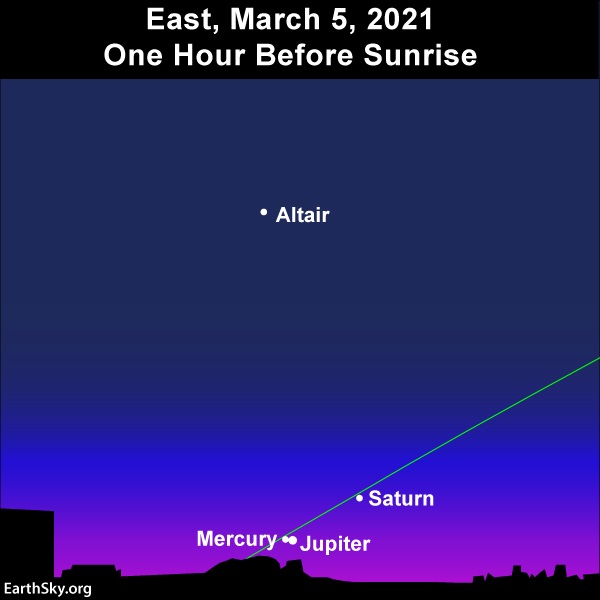
On March 5, 2021, the planets Mercury and Jupiter are in conjunction, but – from northerly latitudes – might be hard to view in the morning twilight. In contrast, the Southern Hemisphere has a good view of these planets, due to the morning angle of the ecliptic at this time of year. Read more.
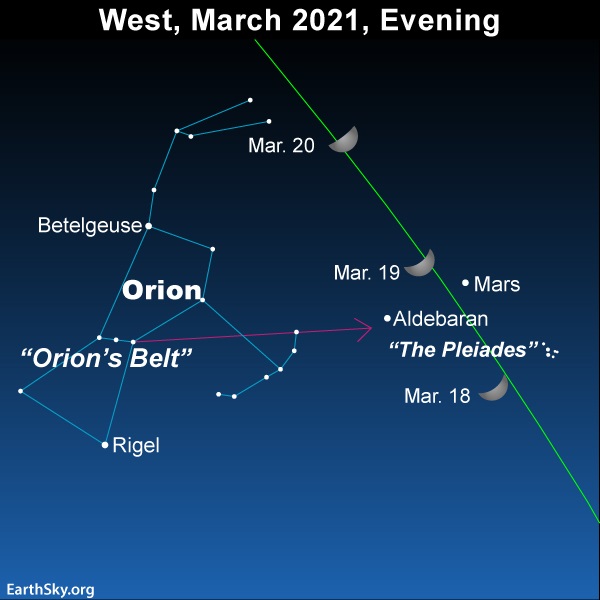
The moon sweeps to the south of the red planet Mars and to the north of the red giant star Aldebaran, as the waxing crescent moon makes its pilgrimage in front of the constellation Taurus on March 18, 19 and 20, 2021. Read more.
Mars is the only bright planet to light up the evening sky in March 2021 (Mercury, Jupiter and Saturn are found in the predawn/dawn sky all month long, and Venus is lost in the sun’s glare). Best to seek out this modestly-bright world at early evening, when it’s still relatively high in the sky. Mars slowly descends westward during the evening hours, finally setting in the west at or around midnight at mid-northern latitudes, and by mid-evening at temperate latitudes in the Southern Hemisphere.
Mars resides in front of the constellation Taurus the Bull from now until well into April 2021. Enjoy Mars in March 2021! It’s only going to get fainter as this year progresses. In the months ahead, Mars will slowly but surely dim as – day by day – it will sink closer and closer to the setting sun.
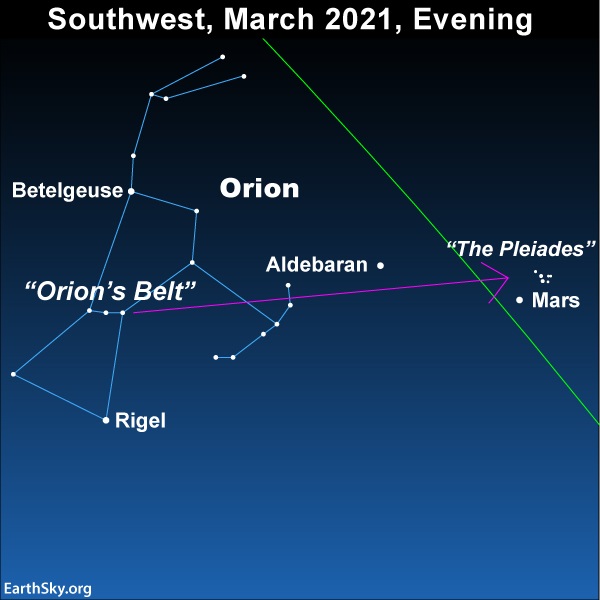
During the first week of March 2021, use Orion’s Belt to star-hop to the planet Mars and the Pleiades star cluster. Read more.
The big event of the month comes in early March, as Mars and the Pleiades star cluster showcase their close conjunction on March 3, 2021. This will be their closest pairing on the sky’s dome since January 20, 1991. A closer Mars-Pleiades conjunction won’t happen again until February 4, 2038.
Let the moon help guide your eye to the red planet for several nights centered on or near March 19.
Read more: What to expect from Mars in 2021
Venus – the brightest planet – reached its greatest elongation of 46 degrees from the sun in the morning sky last year on August 12 or 13, 2020 (depending upon your time zone).
As March 2021 opens, however, Venus sits too close to the rising sun to be visible; and as March 2021 draws to a close, Venus looms too close to the setting sun to be seen. In other words, Venus – in its smaller, faster orbit around the sun – is about to “turn the corner” ahead of us in orbit. On March 26, Venus is to pass on the far side of the sun, to exit the morning sky and to enter the evening sky. That’s when this inferior planet will reach superior conjunction. (See diagram below.)
By late April or May, Venus will return to our skies as an evening “star” near the western horizon. It’ll then be up in the evening, glorious, for the rest of this year.
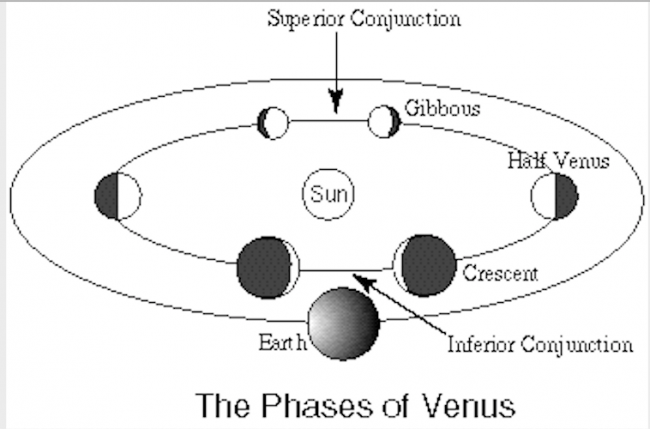
Inferior conjunction – when Venus sweeps between the sun and Earth – happened on June 3, 2020. Some 10 weeks later, Venus reached its greatest elongation, or distance from the sun, in the morning sky on August 13, 2020. Its disk was about 50% illuminated by sunshine. In March 2021, Venus will start the month in the morning sky and end the month in the evening sky. On March 26, 2021, Venus will be at superior conjunction, to exit the morning sky and to enter the evening sky. Image via UCLA.
Jupiter and Saturn remain fairly close together in the eastern predawn/dawn sky throughout March 2021. Saturn rises first and Jupiter follows Saturn into the sky shortly thereafter. From northerly latitudes, Jupiter and Saturn might still be hard to view in the early part of the month. But they’re there, and, day by day, the planetary twosome will rise sooner before sunrise and appear a bit higher in the predawn/dawn sky. For the best view, find an unobstructed horizon in the direction of sunrise. Seek them out with binoculars first. Toward the end of the month, try seeing them with the eye alone.
Mercury, the innermost planet, bunches up with Jupiter and Saturn in the morning sky during the first week of March. Mercury actually has a conjunction with Jupiter on March 5, but his conjunction will probably be difficult to view from northerly latitudes.
Use the moon to help guide you to the morning planets on March 8, 9 and 10.
To find out when Jupiter and Saturn rise into your sky, consult either The Old Farmer’s Almanac (U.S. and Canada) or TimeandDate (worldwide).
As mentioned before, Saturn rises first and then Jupiter follows Saturn. Below we give the rising time for Jupiter, the latter of these two planets to rise, at various latitudes (presuming a level horizon):
40 degrees north latitude
Early March: Jupiter rises about one hour (60 minutes) before the sun
Late March: Jupiter rises about 1 5/6 hours (110 minutes) before the sun
Equator (0 degrees latitude)
Early March: Jupiter rises about 1 1/2 hours (90 minutes) before the sun
Late March: Jupiter rises nearly 3 hours (180 minutes) before the sun
35 degrees south latitude
Early March: Jupiter rises about 2 hours (120 minutes) before the sun
Late March: Jupiter rises 3 3/4 hours (225 minutes) before the sun
Up for a challenge? Try viewing the conjunction of Mercury and Jupiter on March 5.
Mercury is a morning object all through March. Luckily for the Southern Hemisphere, March presents Mercury’s best apparition in the morning sky for the year. Given an unobstructed horizon and clear sky, you should have little trouble catching the Mercury-Jupiter conjunction on March 5, and the slender waning crescent moon sweeping by the three morning planets (Mercury, Jupiter and Saturn) on March 8, 9, 10 and 11. The chart below is for temperate latitudes in the Southern Hemisphere.
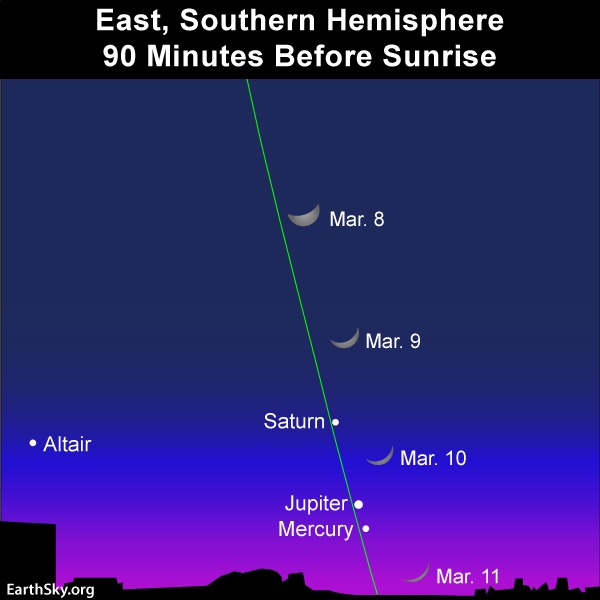
In the month of March, the Southern Hemisphere has a big advantage over the Northern Hemisphere for viewing the morning planets, because of the steep tilt of the ecliptic. Read more.
What do we mean by bright planet? By bright planet, we mean any solar system planet that is easily visible without an optical aid and that has been watched by our ancestors since time immemorial. In their outward order from the sun, the five bright planets are Mercury, Venus, Mars, Jupiter and Saturn. These planets actually do appear bright in our sky. They are typically as bright as – or brighter than – the brightest stars. Plus, these relatively nearby worlds tend to shine with a steadier light than the distant, twinkling stars. You can spot them, and come to know them as faithful friends, if you try.
Bottom line: March 2021 presents four bright planets! Mars is the only bright planet to light up the evening sky. Mercury, Jupiter and Saturn all appear in the east before sunrise, whereas Venus – the brightest planet – hides behind the sun all month long.
Don’t miss anything. Subscribe to EarthSky News by email
Visit EarthSky’s Best Places to Stargaze to find a dark-sky location near you.
Help EarthSky keep going! Donate now.
Post your planet photos at EarthSky Community Photos.
from EarthSky https://ift.tt/1YD00CF

Click the name of a planet to learn more about its visibility in March 2021: Jupiter, Saturn, Mars, Venus, Mercury
Try Stellarium for a precise view of the planets from your location.
Want precise planet rise and set times? Click here for recommended almanacs

The red planet Mars has a conjunction with the Pleiades star cluster every other year. But the Mars-Pleiades conjunction on March 3, 2021, is the closest one since 1991. A closer Mars-Pleiades conjunction won’t occur again until 2038. Read more.

On March 5, 2021, the planets Mercury and Jupiter are in conjunction, but – from northerly latitudes – might be hard to view in the morning twilight. In contrast, the Southern Hemisphere has a good view of these planets, due to the morning angle of the ecliptic at this time of year. Read more.

The moon sweeps to the south of the red planet Mars and to the north of the red giant star Aldebaran, as the waxing crescent moon makes its pilgrimage in front of the constellation Taurus on March 18, 19 and 20, 2021. Read more.
Mars is the only bright planet to light up the evening sky in March 2021 (Mercury, Jupiter and Saturn are found in the predawn/dawn sky all month long, and Venus is lost in the sun’s glare). Best to seek out this modestly-bright world at early evening, when it’s still relatively high in the sky. Mars slowly descends westward during the evening hours, finally setting in the west at or around midnight at mid-northern latitudes, and by mid-evening at temperate latitudes in the Southern Hemisphere.
Mars resides in front of the constellation Taurus the Bull from now until well into April 2021. Enjoy Mars in March 2021! It’s only going to get fainter as this year progresses. In the months ahead, Mars will slowly but surely dim as – day by day – it will sink closer and closer to the setting sun.

During the first week of March 2021, use Orion’s Belt to star-hop to the planet Mars and the Pleiades star cluster. Read more.
The big event of the month comes in early March, as Mars and the Pleiades star cluster showcase their close conjunction on March 3, 2021. This will be their closest pairing on the sky’s dome since January 20, 1991. A closer Mars-Pleiades conjunction won’t happen again until February 4, 2038.
Let the moon help guide your eye to the red planet for several nights centered on or near March 19.
Read more: What to expect from Mars in 2021
Venus – the brightest planet – reached its greatest elongation of 46 degrees from the sun in the morning sky last year on August 12 or 13, 2020 (depending upon your time zone).
As March 2021 opens, however, Venus sits too close to the rising sun to be visible; and as March 2021 draws to a close, Venus looms too close to the setting sun to be seen. In other words, Venus – in its smaller, faster orbit around the sun – is about to “turn the corner” ahead of us in orbit. On March 26, Venus is to pass on the far side of the sun, to exit the morning sky and to enter the evening sky. That’s when this inferior planet will reach superior conjunction. (See diagram below.)
By late April or May, Venus will return to our skies as an evening “star” near the western horizon. It’ll then be up in the evening, glorious, for the rest of this year.

Inferior conjunction – when Venus sweeps between the sun and Earth – happened on June 3, 2020. Some 10 weeks later, Venus reached its greatest elongation, or distance from the sun, in the morning sky on August 13, 2020. Its disk was about 50% illuminated by sunshine. In March 2021, Venus will start the month in the morning sky and end the month in the evening sky. On March 26, 2021, Venus will be at superior conjunction, to exit the morning sky and to enter the evening sky. Image via UCLA.
Jupiter and Saturn remain fairly close together in the eastern predawn/dawn sky throughout March 2021. Saturn rises first and Jupiter follows Saturn into the sky shortly thereafter. From northerly latitudes, Jupiter and Saturn might still be hard to view in the early part of the month. But they’re there, and, day by day, the planetary twosome will rise sooner before sunrise and appear a bit higher in the predawn/dawn sky. For the best view, find an unobstructed horizon in the direction of sunrise. Seek them out with binoculars first. Toward the end of the month, try seeing them with the eye alone.
Mercury, the innermost planet, bunches up with Jupiter and Saturn in the morning sky during the first week of March. Mercury actually has a conjunction with Jupiter on March 5, but his conjunction will probably be difficult to view from northerly latitudes.
Use the moon to help guide you to the morning planets on March 8, 9 and 10.
To find out when Jupiter and Saturn rise into your sky, consult either The Old Farmer’s Almanac (U.S. and Canada) or TimeandDate (worldwide).
As mentioned before, Saturn rises first and then Jupiter follows Saturn. Below we give the rising time for Jupiter, the latter of these two planets to rise, at various latitudes (presuming a level horizon):
40 degrees north latitude
Early March: Jupiter rises about one hour (60 minutes) before the sun
Late March: Jupiter rises about 1 5/6 hours (110 minutes) before the sun
Equator (0 degrees latitude)
Early March: Jupiter rises about 1 1/2 hours (90 minutes) before the sun
Late March: Jupiter rises nearly 3 hours (180 minutes) before the sun
35 degrees south latitude
Early March: Jupiter rises about 2 hours (120 minutes) before the sun
Late March: Jupiter rises 3 3/4 hours (225 minutes) before the sun
Up for a challenge? Try viewing the conjunction of Mercury and Jupiter on March 5.
Mercury is a morning object all through March. Luckily for the Southern Hemisphere, March presents Mercury’s best apparition in the morning sky for the year. Given an unobstructed horizon and clear sky, you should have little trouble catching the Mercury-Jupiter conjunction on March 5, and the slender waning crescent moon sweeping by the three morning planets (Mercury, Jupiter and Saturn) on March 8, 9, 10 and 11. The chart below is for temperate latitudes in the Southern Hemisphere.

In the month of March, the Southern Hemisphere has a big advantage over the Northern Hemisphere for viewing the morning planets, because of the steep tilt of the ecliptic. Read more.
What do we mean by bright planet? By bright planet, we mean any solar system planet that is easily visible without an optical aid and that has been watched by our ancestors since time immemorial. In their outward order from the sun, the five bright planets are Mercury, Venus, Mars, Jupiter and Saturn. These planets actually do appear bright in our sky. They are typically as bright as – or brighter than – the brightest stars. Plus, these relatively nearby worlds tend to shine with a steadier light than the distant, twinkling stars. You can spot them, and come to know them as faithful friends, if you try.
Bottom line: March 2021 presents four bright planets! Mars is the only bright planet to light up the evening sky. Mercury, Jupiter and Saturn all appear in the east before sunrise, whereas Venus – the brightest planet – hides behind the sun all month long.
Don’t miss anything. Subscribe to EarthSky News by email
Visit EarthSky’s Best Places to Stargaze to find a dark-sky location near you.
Help EarthSky keep going! Donate now.
Post your planet photos at EarthSky Community Photos.
from EarthSky https://ift.tt/1YD00CF

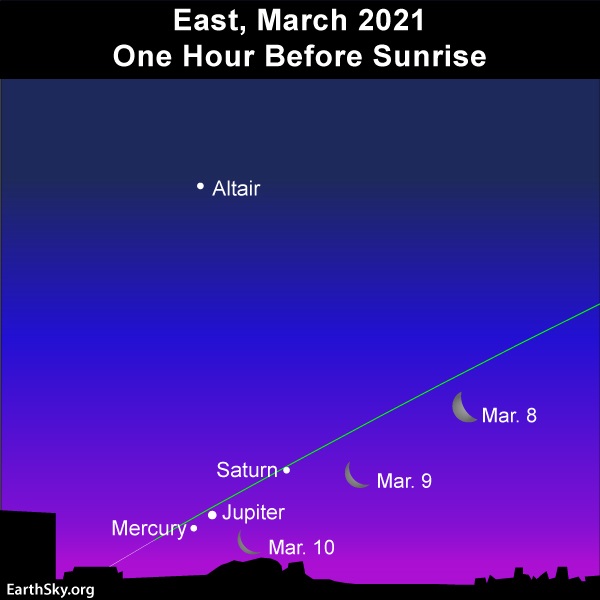

Aucun commentaire:
Enregistrer un commentaire